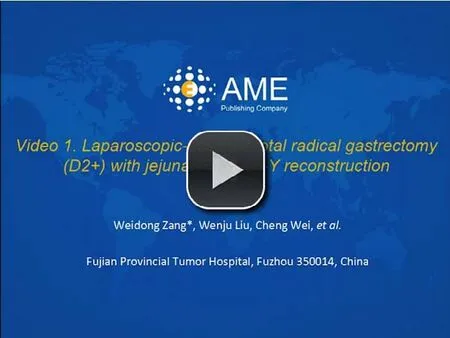Total laparoscopic-assisted radical gastrectomy (D2+) with jejunal Roux-en-Y reconstruction
2013-06-12WeidongZangWenjuLiuChengWeiShifuLiuGuodongZhao
Weidong Zang, Wenju Liu, Cheng Wei, Shifu Liu, Guodong Zhao
1Fujian Provincial Tumor Hospital, Fuzhou 350014, China;2Fujian Yongan Municipal Hospital, Sanming 366000, China;3Haikou People’s Hospital, Haikou 570208, China
Total laparoscopic-assisted radical gastrectomy (D2+) with jejunal Roux-en-Y reconstruction
Weidong Zang1, Wenju Liu1, Cheng Wei1, Shifu Liu2, Guodong Zhao3
1Fujian Provincial Tumor Hospital, Fuzhou 350014, China;2Fujian Yongan Municipal Hospital, Sanming 366000, China;3Haikou People’s Hospital, Haikou 570208, China
Corresponding to:Weidong Zang, M.D. from Fujian Medical University, Associate Chief Physician. Department of Abdominal Surgery, Fujian Provincial Tumor Hospital, Fuzhou 350014, China. Email: 894434459@qq.com.
Total laparoscopic-assisted radical gastrectomy and the jejunal Roux-en-Y anastomosis were performed to treat cancer of the upper gastric body and fundic region. In the case of open anastomosis during total laparoscopic-assisted radical gastrectomy, an incision of 6-8 cm would be required due to the need for placing the stapler anvil. If using the Roux-en-Y procedure, however, the incision could be reduced to as small as 4-5 cm without increasing the length of operation and intraoperative bleeding that favors postoperative recovery.
Gastric cancer; laparoscopy; gastrectomy; gastrointestinal anastomosis
Scan to your mobile device or view this article at:http://www.thecjcr.org/article/view/2538/3411
A 42-year-old woman was admitted for “repeated abdominal pain and discomfort for more than a month.” Gastroscopic pathology showed adenocarcinoma of the “gastric angle and gastric body” (NO: 13-10963). CT indicated gastric cancer and abdominal lymph node metastases. Ultrasound showed a solid mass in the lower gastric body and the lesser curvature side of the gastric angle (gastric cancer was suspected, which had protruded the serosal layer, Borrmann III type), complicated with multiple enlarged lymph nodes close to the lesser curvature suspected of metastases. The preoperative diagnosis was gastric cancer, stating T3N1M0IIB. “Total laparoscopic-assisted radical gastrectomy (D2+) and jejunal Roux-en-Y reconstruction”was performed under general anesthesia on May 3, 2013.
In this surgery (Video 1), the patient is placed in supine position with legs apart. Routine disinfection and draping of the surgical area is performed after successful endotracheal and intravenous anesthesia. The surgeon stands on the left side of the patient, the first assistant on the right side, and the camera assistance between the patient’s legs. A 1-cm incision is made above the umbilicus for placement of a trocar. Pneumoperitoneum of 12 mmHg is established, and a 30-degree laparoscope is inserted. Abdominal exploration shows no ascites, and no evident mass of the liver, parietal peritoneum, or greater omentum. An infiltrative, ulcerative tumor is visible at the lesser curvature of the gastric body (Borrmann III), about 5 cm × 3 cm in size, which is solid and invading the serosa. Stations 1, 2, 7, 8, 11 and 12 lymph nodes are enlarged in a diameter of about 0.8 cm, which are moderately solid without fusion. Trocars are inserted using the 5-port technique. An ultrasonic scalpel is used to cut the greater omentum and the anterior lobe of the transverse mesocolon. The right gastroepiploic artery and vein are ligated at their roots and cut. Station number 6 lymph nodes are dissected, and the pancreatic capsule to the upper left area is cut. The left gastric vein and artery are successively transected. Stations number 7, 9 and 8 lymph nodes are dissected, through to the station 11d, and the dissection is continued to stations 4sh, 10, 4sa and 2 lymph nodes at the left upper region. In the anterior region, the small omentum is resected, and stations 3 and 1 lymph nodes are dissected. The duodenum is transected using a linear stapler, and stations 12p and 8p lymph nodes are dissected. The abdominal segment of the esophagusis cut with the linear stapler, and one suture is made for retraction. The transverse mesocolon is open, and the jejunum is dissociated by an ultrasonic scalpel 20 cm away from the Treitz ligament. The wall at the mesangial side is denuded. A hole is made to the esophagus with the scalpel, and a 60 mm linear stapler is inserted with the two ends at the distal stumps of the esophagus and the jejunum to establish the end-to-side anastomosis. Two sutures are made to the common opening at the side of the anastomosis for retraction, and the 60 mm linear stapler is again inserted to cut the tissue to complete the anastomosis. The stomach and the omental bursa are completely resected. A small hole is made using the ultrasonic scalpel about 40 cm below the opening of the anastomosis at the mesenteric edge for placement of the two firings of a 60 mm linear stapler through the proximal stump. Upon completion of the anastomosis, the two jejunal segments with a common opening are held with harmless forceps, and a 60 mm linear stapler is inserted to complete the jejunal Roux-en-Y anastomosis. When no anastomosis stenosis and bleeding is detected, a central incision of 4 cm is made to the upper abdomen to collect the total gastrectomy specimen, and the laparoscopic resection and anastomoses are completed.

Video 1 Laparoscopic-assisted radical gastrectomy (D2+) with jejunal Roux-en-Y reconstruction
The surgery was uneventful. The operation time was 192 minutes, with intraoperative blood loss of about 60 mL. A feeding tube was inserted, in conjunction with antibiotics and nutritional support. A small dose of Peptison was administered through the nasogastric tube on the first day. Flatus and little bowel movement occurred on the morning of the third day. As the blood testing results and temperature gradually returned to normal, the nasogastric amount was increased as well. Semi-liquid food was given from the fifth day, and the patient was discharged on the eighth day after surgery. No obvious complication was observed after 30 days. Postoperative pathology showed: total gastrectomy specimen: (gastric lesser curvature) ulcerated moderately differentiated adenocarcinoma (tumor size 5.5 cm × 4 cm), involving the serosal fat and nerve; tumor vascular thrombosis was found; the upper and lower margins of the specimens, as well as the separate“upper resected margin” were negative for tumor tissue. Metastases were observed in the lesser curvature LN2/2, greater curvature LN1/3,“Station 1” LN0/8, “Station 2”LN0/2, “Station 3” LN0/14, “Station 6” LN0/4, “Station 7”LN0/2, “Station 8” LN1/3, “Station 9” LN0/2, and “Station 10” LN0/1. No LN was detected in “stations 5, 11 and 12.” IHC: tumor cells CgA (-), Syn focal (+), CD56 (-), CK8/18 (+), CK7 (-), Ki-67 20% (+). Pathologic staging was T4aN2MoIIIB.
Acknowledgements
Disclosure: The authors declare no conflict of interest.
Cite this article as:Zang W, Liu W, Wei C, Liu S, Zhao G. Total laparoscopic-assisted radical gastrectomy (D2+) with jejunal Roux-en-Y reconstruction. Chin J Cancer Res 2013;25(4):455-456. doi: 10.3978/j.issn.1000-9604.2013.08.05

10.3978/j.issn.1000-9604.2013.08.05
Submitted Jul 02, 2013. Accepted for publication Jul 07, 2013.
杂志排行
Chinese Journal of Cancer Research的其它文章
- Retreatment of a patient who presented with synchronous multiple primary colorectal carcinoma: report of a case
- Laparoscopic-assisted radical gastrectomy for distal gastric cancer
- Laparoscopy-assisted D2 radical distal gastrectomy for gastric cancer (Billroth II anastomosis)
- The role of circadian rhythm in breast cancer
- Laparoscopic gastrectomy for distal gastric cancer
- D2 plus radical resection combined with perioperative chemotherapy for advanced gastric cancer with pyloric obstruction
